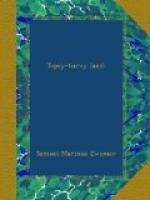Arabic grammar is much more difficult than English grammar, and even the boys who attend the big Arabic college of El Azhar in Cairo, Egypt, must find its study a bugbear. Just think of learning fifteen conjugations instead of the much smaller number in Latin or Greek! The books used in Moslem schools would look very crude and dull to you who learnt your A, B, C, from an illustrated primer perhaps with coloured pictures.
Strict Mohammedans do not allow their boys and girls to have pictures in their books, because they say all pictures are idols. And yet the love for beauty and the desire for ornament on the written or printed page was so strong with the Arabs that they began from the earliest times to use their alphabet to make arabesques. Arabesque is a big word and it really means an Arab picture. But these pictures of the Arabs (which you find on the arches of old mosques, in books and on tombstones) are ornaments or designs made out of the beautifully curved letters of the alphabet. The old Arab copyists and their sculptors wrote and carved the words of the Koran, or the names of God, etc., in all sorts of ways to make pictures out of words only, lest they break the law of their prophet. Here are two examples of how pictures can be made out of letters. You have all doubtless heard of a “wordless book”; and some of you have books without words and full of pictures. Here is a picture made out of the Arabic alphabet, and every curve and dot belongs to the words so curiously written. I copied them out of an Arabic treatise on penmanship, for you. The face is not at all pretty, and yet Moslem lads think it is very clever to bring this likeness of man out of the four names, Allah, Mohammed, Ali and Hassan. These words you notice are written twice, both to the left and to the right. What a disgrace to the holy name of God to put that of three Arabs with it in a monograph! It is very sad to hear some Moslems say that they trust in these people to intercede for them with God. If you have read what sinful lives these people led when they were the chief rulers in Arabia, you will almost agree with me in calling this first picture a Moslem idol.
[Illustration: DESIGNS MADE OUT OF ARABIC WRITING.]
There are many Moslems in Bahrein who have hanging up in their rooms these monograms or designs. One favourite I have often seen contains only five names: Allah, Mohammed, Ali, Hassan and Hussein. The people who make so much of these descendants of Mohammed are called Shiahs; the other Moslems who think they are more orthodox are called Sunnites.




